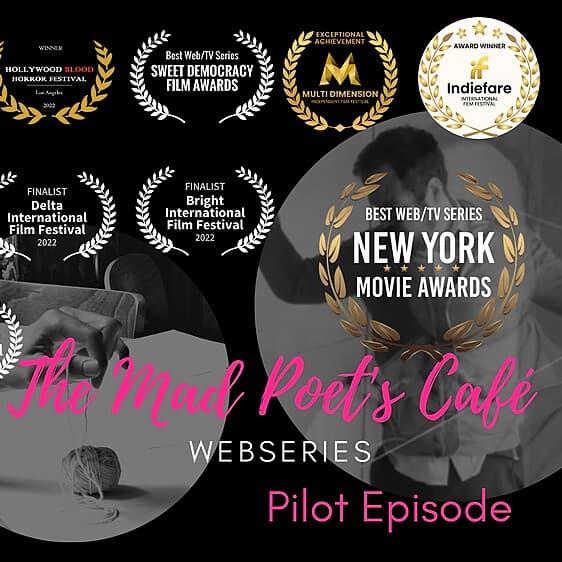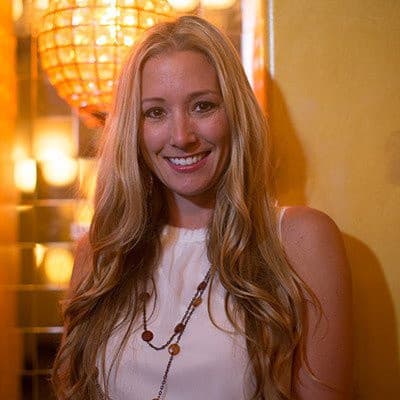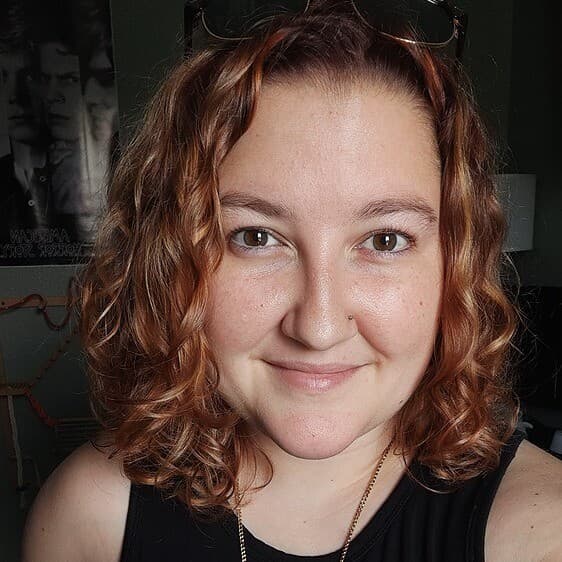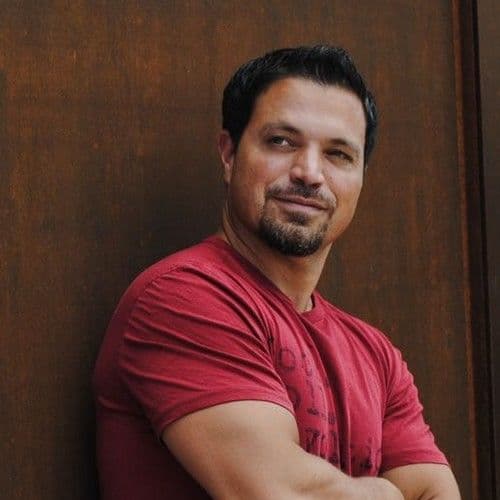How To Film A Series Remotely

A few years ago, I and a producer chum were sitting in a cafe in London, observing the interesting customers it attracted. It wasn't just any cafe: it was a Poetry Cafe with a downstairs space for concerts, open mic nights, and so on. The people we saw coming in, sitting in corners, hiding under their hats, reading, or discoursing at length about whether or not there was quinoa in this or that dish .... it got us scurrying into our notebooks and exchanging anecdotes of various cafe experiences. As the list of ideas grew, we decided to make a web series where all these characters met in a poetry cafe. And so, the Mad Poet's Cafe webseries was born.
Fast forward to the pandemic, and... I was coming up to the end of my MA on filmmaking. Recklessly or otherwise, I had chosen the pilot episode of our web series as the 'deliverable'. And I was getting a little anxious as to how I was going to achieve the actual filming of it. Here's how we got it made...
In 2020, I got together with some actors, and we tried out filming a few shorts remotely. The experience was fun and positive, encouraging my interest in the technique.
Like many of us, I had seen how some companies had held up productions due to the nature of their films. Others, meanwhile, produced content within the framework of social distancing, adopting remote filming as part of the process and context. For example, BBC’s STAGED and NBC’s PARKS & RECREATION REUNION via Zoom. Remote filming has also been quoted as a necessity for Hollywood to get to grips with or fold, with predictions made on the potential benefits:
"The studio will increasingly be a mindset versus a physical location as talent becomes less tied to geography. This will result in talent that is more dispersed, more productive, and cheaper to hire. We’ll also see more low-touch workflows, in contrast to studios who have people lined up in a control room doing the traditional editing and post processes." -- Peter Jackson, July 1, 2020

Online or off?
"The best way to be conversant with an actor’s abilities ….is to have worked with her before. There is no shortcut to this knowledge." (Weston, Directing Actors, 2019)
When the time came to complete my "MA deliverable" (filming the pilot episode of The Mad Poet's Cafe web series), I chose to film at least a part of it remotely. This solved several immediate problems (filming location and actors’ location), and I could move forward in preparations.
With a network of actors to hand, casting was the least problematic; connections led to most roles being filled within a couple of weeks.
I knew their range and skills and saw how they would fit the role. This also saved on rehearsal time as the actors could ‘feel’ the part already from the table read. It also helped that some of the cast had worked with each other before - saving time and extending the ‘family.’
As part of the process (through table reads), I introduced warm-ups and surrealist games; these helped to develop relationships, as well as ice-breakers for those who had not been involved before.
Then, while we were doing an initial table read online, one of the actors offered access to a location that she managed. The end of Lockdown was in sight, and while some of the cast would still be located in other countries, at least five other actors would be able to film ensemble scenes together in one frame.
Suddenly, seemingly out of nowhere, I had cast, location, and crew - as most of the cast ended up taking a hand in the camera work.
Remote filming in France
"All film is, finally, a “dream sequence.” Mamet, 1992
One of the roles (Hat Guy) had been assigned to a French actor based in France for lockdown. We, therefore, began filming his scenes remotely in Paris.
This involved green screen(s), an antique gramophone player, and silk flowers. We used a green cloth with a standing green screen for backup.

We started by filming the shots with the gramophone player; this took less than a day.
Originally I had planned to source a prop gramophone player; we still had zero budget, and ideally, we needed one that actually had a functioning turntable. While filming another short with the same actor earlier during the lockdown, I observed there was a gramophone player in the room and asked if we could use it for the current project. The actor kindly agreed, and after some discussion of the shots needed, I prepared and sent through a specific, illustrated shot list.
The Hat Guy/gramophone scenes were shot out of sequence, broken up over a series of days/weeks, depending on the availability of the actor. A green screen was set up behind the gramophone player, and we adjusted the angles of the camera as necessary to avoid moving the antique as much as possible. At one point, we did move the table (it was on wheels) to be able to accommodate it within the frame.
Modifications to script
In the original script, I had a non-speaking female character in a hat and layers of clothing approach the player to then place flowers before it and leave.
Because it was important to have the gramophone player in the shot (but we did not have a female extra available), I discussed the shot with Hat Guy and suggested he take on the action of placing the flowers himself: this effectively tied in with his character as a poet/reader of poetry.
From my original choice of purple iris and yellow daffodils, we switched to red silk poppies and roses, which were already available. We made several shots with both poppies and roses together and separately. Ultimately I chose the shots with the single rose.
Difficulty and resolution
After a couple of test runs, the actor, using a green screen and cloth, produced the flowers from his coat with a flourish and got up to place the flowers at the base of the gramophone player.
We had some difficulty with the flowers overbalancing and falling off the edge of the player support table, and it took 4 to 5 takes to get the desired result. In addition, the green cloth, at times, did not quite cover the background. In this case, it could be remedied by cropping, as the shot was intended to be a close-up.
This image became one of my favorite shots of the whole episode, and I have used it in film promo material.
Filming with actors and animals
Hat Guy had several interactions in the script with a cat, who wanders in early on in the episode and proceeds to torment Hat Guy (who is terrified of cats).
The actor came up with suggestions for camera angles for his scenes with the cat. By happy coincidence, his brother had two cats whom he agreed to let us film. This also saved time, as the actor was already familiar with the cat(s) in question, and his brother was on standby as a handler. So ‘Freddy’ was introduced to the team.
The filming took place in one afternoon, and with treats and play, ‘Freddy’ performed his part purrfectly (and I believe to his own complete satisfaction); we now had the material we needed to complete the scenes with Hat Guy. The clips were sent through on the same day, and I proceeded to edit and insert them.

Remote in Italy
Our other ‘remote’ team was in Italy; a Hungarian actor and his brother/cameraman. Again, serendipity played a hand - there happened to be a trattoria near where they were located which contained the right kind of furniture; props did not have to be sourced as they had everything to hand. Through the use of mid-shots and close-ups, it could look as though part of the same location we were using in London.
Aside from these and various selfie shots from the Dudettes, there remained the Gardener. I had an experienced and multi-skilled actor for this, who is himself a filmmaker, equipped and familiar with green screen, self-filming, and lighting.
I was lucky to have good actors - actors who already understood about listening to each other, who understood about allowing their subconscious to work with the character, to allow themselves to be free. This meant that when it came to shooting in a short space of time, I didn’t have to repeat, I was able to focus on blocking, framing, and let the camera run. The sensitivity, the craft, and the nuances all came across - even if the actors themselves were not consciously aware of this.
On location
We had one half-day to film on location; we followed through brief rehearsals, ran lines, tried out test runs, and filmed.
Shooting:
“Shooting should be seen as an extension of the rehearsal - and better than rehearsal - that is, unpressured, exploratory, free - and better than rehearsal, a treat and an adventure.”[p.281]
On the day of the shoot on location, I found the actors were primed, and the energy was high. This was, for many, an opportunity to do something creative with others for the first time since Lockdown began, and this added an extra layer of subtle positive energy to the generally festive feel on location; there was chatter, there was laughter, and there were hugs, - the ‘magic time’ that Judith Weston refers to.
This continued into the rehearsal process - I wanted to keep it as relaxed and casual as possible, to allow the magic to remain with us, and by keeping it playful, maintain the aspect of other-worldliness.
I encouraged surrealist activities as a way of helping the actors to free themselves and thereby free their performances, both during rehearsal and before the camera. Feedback suggested the actors enjoyed the activities and found them helpful.
Blocking
“If you love a piece of business, let it free.” (Weston, Directing Actors 2019)
I had loosely based the storyboard around the location we had originally planned the series, an actual Poetry Society Cafe in London. The shot lists, meanwhile, were prepared after rehearsal and discussion and modified as required.
Although I had shared the storyboard with the actors, there were details of blocking necessarily left until the day of the shoot, where I made on-the-spot adjustments; these were choices made based on the layout of the location. They were ‘options’ I had available to help position the actors so as to be in the correct space, with more options developing as the shoot progressed.
Finding opportunities on set: examples
Ordering at the bar:
The film location was L-shaped; the entrance was flanked by tables leading to the bar counter. The counter was screened, with the cashier's desk at the far end.
While setting up on location, I noticed a pot plant and pillar framing off a part of the counter, creating a narrow aperture between them and the cashier desk; it would make for an awkward position to order from, and as such, seemed perfectly in tune with the general oddness, style-wise, that I was looking for. The scene required five actors to be ordering their drinks at the bar all at the same time; instead of the standard lineup I had originally envisaged, I grouped the actors together in one crowded frame shot, at the narrow opening described above, to give the impression of striving over one another to give their orders; this I felt helped add extra punch and tension to the delivery.
An Entrance:
In the original storyboard, I had outlined the Dudettes initially as shadowy silhouettes vaguely seen in the background. Their entrance was heard (off-screen)rather than seen. On location, I noted a set of windows near the entrance framed by green plants and did a test shot of the Three Dudettes walking past outside, stopping to look at something on their phones, and delivering their first line. I had to rearrange the blocking again very slightly, owing to the difference in height, and to avoid the first actress being partially covered by the window plants. We went for a successful second take; this gave a direct visual introduction to the characters as opposed to the original off-screen one, with an effect of immediacy, a sense of ‘in-your-face’ more in line with their personalities.
Take One, Two, Three….
"Actors, even if you have procured them for free, always like acting, so do another lens angle, another lens attitude." Thurlow, 2012
I am indebted to the cast for their commitment to this project.
I would have gone with the first takes (and in most cases used these, as the first tend to be the freshest)but I am grateful for their dedication to their art in asking to re-take shots so that they felt they could give off their best, and I had more options to choose from.

Expectations
While filming so far, I have noticed ideas leading to more ideas, which more often than not help the film to develop its own voice and theme. Ultimately, I do not expect the result to be an exact replica of what I designed originally - nor do I believe I would want that.
I found that flexibility encourages narrative development and the evolution of design. This, combined with the ‘right’ casting, and directing, can allow for a production to develop its full potential.
The Plan - and Serendipity
“Sometimes there’s just some wonderful magic that happens, a perfect synergy on set, ….” (Watterson, cited in Risker, 2019)
I discovered that success is also reliant on openness to solutions and flexibility. Some people might refer to a plan B, plan C, and so on. I would like to add the ‘Allow for Serendipity’ plan.
There were few possibilities available regarding location - unless you had a budget to burn. It was only after we had done a table read that the offer came from one of the cast of using a location in central London that contained all the elements necessary for the script.
The role of Silent Guy was the last to be cast. Again, through contacts, we were offered access to both actor and cameraman, with an ideal taverna as the location in Italy. I sent through an illustrated shot list, they filmed the next day, and I received the clips within the week. All of this by coincidence: the actors happened to be available, and the location happened to be available.
Through sheer chance, the flooring, and the furniture in each location happened to match or blend well, well enough to give the impression of being in the same space.
The same chance found us props (like the gramophone player) and a cat; these, too, just happened to be in the right place at the right time.
Naturally, the whole was helped by it being a surrealist concept to begin with - any oddness or disparity would be a bonus, something to be added to the dream-like, absurdist quality of the whole.
Even more importantly, the creative process was stimulated, resulting in improvements and resolutions not previously imagined or expected.
Let's hear your thoughts in the comments below!
Got an idea for a post? Or have you collaborated with Stage 32 members to create a project? We'd love to hear about it. Email Emily at emily@stage32.com, and let's get your post published!
Please help support your fellow Stage 32ers by sharing this on social. Check out the social media buttons at the top to share on Instagram @stage32, Twitter @stage32, Facebook @stage32, and LinkedIn @stage-32.
About the Author

Julia Warren
Author, Editor, Filmmaker, Illustrator, Playwright, Screenwriter, Stage Director, Voice Artist
BA in Fine Art (Accademia di Bella Arti 2005); MA in Filmmaking, designer, illustrator, filmmaker & stage director (incl.The Santa Crisis, Horatio Productions Sci-fi festival); author of mystery novels )





